
MTG is one of the most popular card games on the planet. Millions of players collect cards as collectibles. While other players are caught up in epic monster battles. But to guarantee victory in battle, each player must have a successful deck.
MTG is a complex game that requires careful deck building and strategic play. Today, there are many ways to build a successful gaming deck. But each method has its rules and principles. Each player needs not only to collect strong monsters. It is also important for players to consider card synergy, colors, and spells.
One of the key components of deck building is choosing the right color combinations. You can mix red, black, green, white, and blue MTG colors. In this article, we will explore tri-color MTG pairings, their strengths, and weaknesses, and provide tips for building a winning deck.
What Are Tri-Color Pairings?
In MTG, tri-color pairings refer to decks that incorporate three different colors of mana. A pairing is the combination of two colors in a deck. And a tri-color pairing refers to three colors used together in a deck.
There are ten possible tri-color pairings in MTG. Each comprises a combination of three of the five colors of mana:
- White;
- Blue;
- Black;
- Red;
- Green.
These pairings are often referred to by their shorthand names. They're based on the names of the corresponding shards or wedges from the game's lore.
But to build a beneficial combination, you should follow some rules for using colors.
Strengths And Weaknesses Of Tri-Color Pairings
Building a strong deck is a challenge, even for MTG pros. All because MTG has many color variations. Thus, deck building often causes difficulties for players.
In the following blocks, we will tell you about popular tri-color MTG decks. We will also show you the advantages and disadvantages of such decks. This information lets you choose the most suitable deck for your play style.
It doesn't matter if you are an aggressive player or prefer slow tactics. Our deck list has something unique for every player.
White-Blue-Black (Esper)
This tri-color Magic deck is a popular color combination in Magic: The Gathering. It's known for its strong control and removal capabilities.
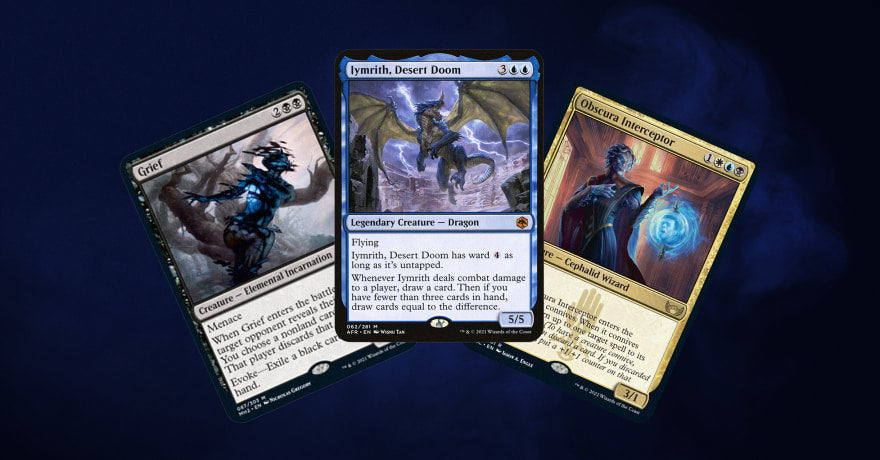
|
Strengths |
Weaknesses |
|
One of the key strengths of Esper is its ability to control the board and disrupt the opponent's strategy. Cards like Path to Exile, Fatal Push, and Counterspell are common in Esper decks. They allow them to remove threats and prevent opponents from executing game plan. Also, the combination of white, blue, and black allows for various card drawing and filtering effects. It gives players access to the cards they need to win the game. |
The main weakness of Esper is its reliance on its mana base. As a three-color combination, it can be difficult to balance the number of lands and colored mana sources. It leads to inconsistent draws and difficulties casting spells. Also, the deck is vulnerable to cards targeting its colors, such as Blood Moon or Choke. |
Popular Esper Decks:
- Esper Control. It focuses on controlling the board and outlasting the opponent with card advantage;
- Esper Stoneblade. It combines control elements with the powerful equipment card, Stoneforge Mystic;
- Esper Dragons. It uses powerful dragons like Silumgar, the Drifting Death, and Ojutai, the Soul of Winter. It controls the board while dealing damage to the opponent.
Red-Blue-Green (Temur)
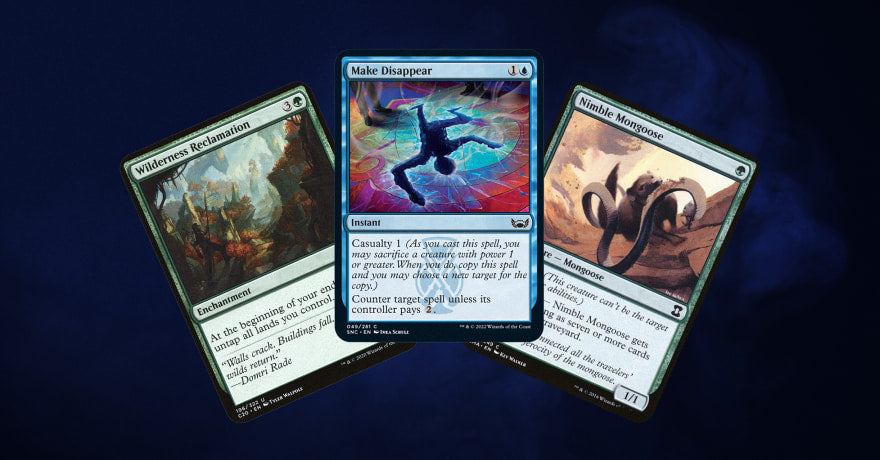
This tri-color Magic deck emphasizes tempo and creature-based strategies. The combination of red, blue, and green allows for various spells. They can deal with threats and enable powerful creatures. And this makes it a versatile and aggressive color combination.
|
Strengths |
Weaknesses |
|
One of the key strengths of Temur is its ability to generate tempo and deal with threats efficiently. Lightning Bolt, Mana Leak, and Dismember are common in Temur decks. Also, the mix of colors allows for a variety of powerful creatures. Tarmogoyf, Snapcaster Mage, and Delver of Secrets can quickly close out games. |
The main weakness of Temur is its vulnerability to board wipes and removal spells. It can struggle against decks with many removal or sweepers that can clear the board. Also, the deck can struggle against decks with large creatures. They are usually difficult to deal with. |
Popular Temur Decks:
- Temur Delver. It focuses on using cheap, efficient creatures and spells;
- Temur Reclamation. It combines control elements with the powerful card, Wilderness Reclamation;
- Temur Midrange. It focuses on using powerful creatures and planeswalkers. They control the board and deal damage over time.
White-Black-Green (Abzan)

This green-white-black MTG combination emphasizes resilience and creature-based strategies.
|
Strengths |
Weaknesses |
|
One of the key strengths of Abzan is its ability to generate value and grind out games. Siege Rhino, Lingering Souls, and Assassin's Trophy are common in Abzan decks. It allows them to remove threats and generate card advantage. Also, the green-white-black MTG combination helps to get powerful creatures. Tarmogoyf, Knight of the Reliquary, and Winding Constrictor can quickly overwhelm opponents. |
The main weakness of Abzan is its vulnerability to faster and more aggressive decks. As a slower, more value-oriented strategy, Abzan decks can struggle against decks with a lot of cheap, efficient creatures or can quickly close out games. |
Popular Abzan Decks:
- Abzan Midrange. It focuses on using powerful creatures and spells to control the board;
- Abzan Company. It combines creature-based strategies with the powerful combo card, Collected Company. It generates value and sets up a powerful combo finish;
- Abzan Tokens is also a popular deck. It focuses on using tokens and creature-based strategies.
Blue-Black-Red (Grixis)
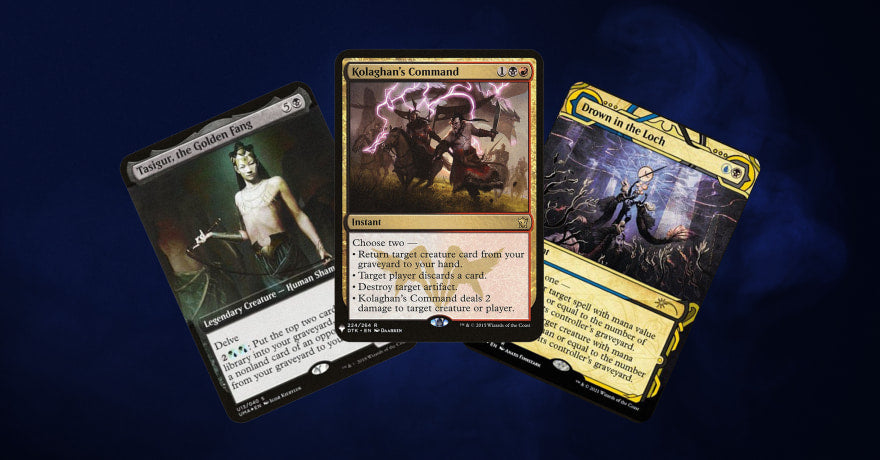
Red-blue-black MTG combo emphasizes control and disruption. The combination of blue, black, and red allows for various spells. They can counter threats, remove creatures, and burn opponents.
|
Strengths |
Weaknesses |
|
One of the key strengths of Grixis is its ability to control the game and disrupt the opponent's strategy. Counterspell, Fatal Push, and Lightning Bolt are common in Grixis decks. Also, the Red-blue-black MTG mix allows for various powerful spells. Cryptic Command, Kolaghan's Command, and Snapcaster Mage quickly change the game. |
The main weakness of Grixis is its vulnerability to aggressive strategies. As a slower, more control-oriented strategy, Grixis decks can struggle against decks with a lot of cheap, efficient creatures. Also, Grixis can struggle against decks that have a lot of disruption. |
Popular Grixis Decks:
- Grixis Control. It focuses on using powerful spells and efficient removal;
- Grixis Death's Shadow. It combines control elements with the powerful creature, Death's Shadow;
- Grixis Delver. It focuses on using cheap, efficient creatures and spells. They are to control the board and deal damage.
Black-Red-Green (Jund)

This 3 color combination in MTG is a powerful and popular combination. It emphasizes aggression and value. The combination of colors allows for a wide range of spells. They can deal with threats, generate card advantage, and enable powerful creatures.
|
Strengths |
Weaknesses |
|
The first one is its ability to generate value and aggression simultaneously. Bloodbraid Elf, Tarmogoyf, and Kolaghan's Command are common in Jund decks. They remove threats, generate card advantage, and deal damage quickly. Also, Scavenging Ooze, Dark Confidant, and Huntmaster of the Fells quickly overwhelm opponents. |
The main weakness of Jund is its vulnerability to faster and more aggressive decks. Jund decks can struggle against decks with many cheap creatures. And it struggles against decks that can quickly close out games. |
Popular Jund Decks:
- Jund Midrange. It focuses on using powerful creatures and spells. They control the board and generate value.
- Jund Death's Shadow. It combines aggressive elements with the powerful creature Death's Shadow.
- Jund Food. The deck focuses on using food tokens and creature-based strategies. They control the board and deal damage over time.
White-Red-Green (Naya)

This 3 color combination in MTG is defined by its emphasis on aggressive creatures, strong combat tricks, and powerful spells. This color combination is popular for its versatility and flexibility.
|
Strengths |
Weaknesses |
|
Naya decks can deploy a diverse array of creatures with strong abilities. They can deal with damage quickly and efficiently. Powerful combat tricks and removal spells often support these creatures. They allow players to maintain control of the battlefield and cut opposing threats. |
One common weakness is their reliance on creature-based strategies. It can make them vulnerable to removal spells and board wipes. Also, Naya decks may struggle against decks focusing on controlling the battlefield. |
Popular Naya Decks:
- Naya Zoo. It focuses on using powerful creatures and spells to deal damage quickly;
- Naya Landfall. It combines creature-based strategies with landfall triggers;
- Naya Titanshift. It's a popular deck that focuses on using the powerful land.
Blue-Black-Green (Sultai)
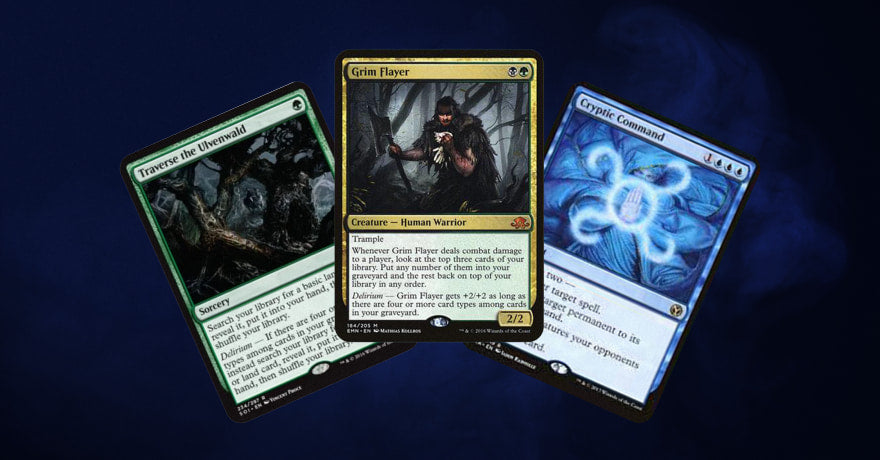
This three color combination MTG emphasizes control and midrange strategies. The combination of blue, black, and green allows for various spells. They all can control the board and disrupt the opponent's hand.
|
Strengths |
Weaknesses |
|
One of the key strengths of Sultai is its ability to generate card advantage and control the board. Thoughtseize, Fatal Push, and Assassin's Trophy are common in Sultai decks. They disrupt the opponent's game plan and cut threats. Sultai generates a card advantage. It uses spells like Jace, the Mind Sculptor, Tarmogoyf, and Snapcaster Mage. It allows the player to outvalue the opponent over time. |
The main weakness of Sultai is its vulnerability to aggressive decks. Sultai decks can struggle against decks with cheap, aggressive creatures. Also, Sultai struggles against decks with enchantment removal. |
Popular Sultai Decks:
- Sultai Control. It focuses on using a variety of spells to control the board and generate card advantage;
- Sultai Reclamation. It combines control and ramp strategies to generate a lot of mana and cast powerful spells;
- Sultai Delirium. This deck focuses on generating card advantage through a variety of card types.
White-Blue-Red (Jeskai)

Blue-red-white MTG Jeskai is a versatile color combination. It emphasizes control and tempo strategies. The combination of colors allows for a variety of spells. They control the board and disrupt the opponent's game plan. With them, you can generate incremental advantages.
|
Strengths |
Weaknesses |
|
One of the key strengths of Jeskai is its ability to control the board and disrupt the opponent's game plan. Lightning Bolt, Path to Exile, and Counterspell are common in blue-red-white MTG decks. It allows them to cut threats and prevent opponents from executing the game plan. Also, Jeskai can generate incremental advantage through spells. They are Snapcaster Mage, Lightning Helix, and Teferi, Hero of Dominaria. |
The main weakness of Jeskai is its vulnerability to combo decks. As a control and tempo strategy, it can struggle against some decks. Those can quickly assemble a powerful combo or easily disrupt their game plan. Also, Jeskai can struggle against decks with a lot of aggressive creatures. |
Popular red-white-blue MTG Decks:
- Jeskai Control. It focuses on using a variety of spells to control the board and disrupt the opponent's game plan;
- Jeskai Tempo. It combines control and aggressive strategies. And it puts pressure on the opponent and controls the board;
- Jeskai Midrange. This red-white-blue MTG deck focuses on generating incremental advantage and playing a variety of powerful threats.
Black-Red-Blue (Grixis)

Grixis emphasizes disruption, control, and resource denial. The combination of black, red, and blue allows for various spells.
|
Strengths |
Weaknesses |
|
One of the key strengths of Grixis is its ability to disrupt the opponent's game plan and control the board. Thoughtseize, Fatal Push, and Counterspell are common in Grixis decks. Also, Grixis can generate card advantage through spells. You can use Snapcaster Mage, Kolaghan's Command, and Jace, Vryn's Prodigy. |
The main weakness of this three color combination MTG is its vulnerability to aggressive decks. As a control and disruption strategy, Grixis decks can struggle against some decks. Those can quickly assemble a board of aggressive creatures or deal a lot of damage early on. |
Popular Grixis Decks:
- Grixis Control. It focuses on using a variety of spells to control the board and disrupt the opponent's game plan;
- Grixis Delver. It combines control and aggressive strategies;
- Grixis Shadow. This focuses on using cheap creatures.
White-Black-Red (Mardu)
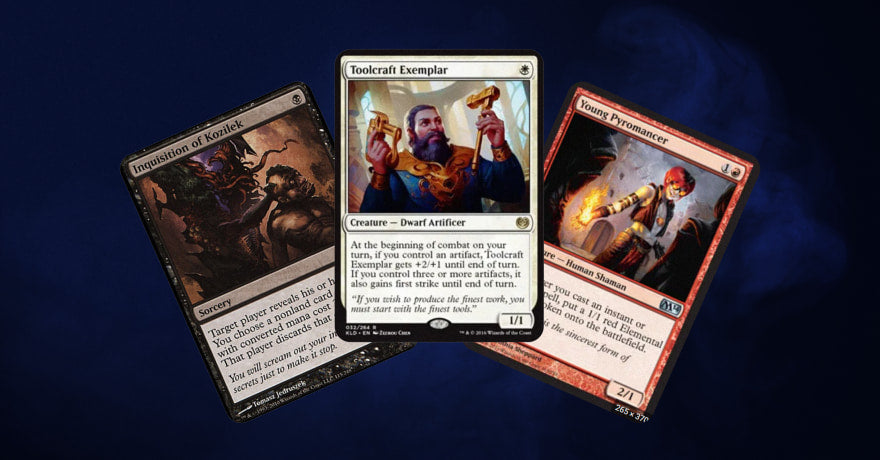
This tri-color MTG is a powerful color combination. It emphasizes aggression, removal, and sacrifice mechanics. The combination of white, black, and red allows various spells and creatures. It can deal with damage quickly and remove opposing threats.
|
Strengths |
Weaknesses |
|
One of the key strengths of Mardu is its ability to put pressure on the opponent and deal damage quickly. Lightning Bolt, Path to Exile, and Lingering Souls are common in Mardu decks. They deal with opposing threats while building up their board. Also, Mardu can generate value through sacrifice mechanics. Blood Artist, Falkenrath Aristocrat, and Village Rites allow the player to gain value. And you can do it even when creatures are removed. |
The main weakness of Mardu is its vulnerability to control decks. As an aggressive strategy, Mardu decks can struggle against some decks. They can easily remove their creatures and disrupt their game plan. Also, Mardu can be weak against decks that can quickly assemble a board and deal damage early on. |
Popular Mardu Decks:
- Mardu Pyromancer. It combines aggressive creatures with spells that generate tokens and removal;
- Mardu Vehicles. It focuses on using artifact creatures and vehicles;
- Mardu Control. It's a popular control deck. It focuses on using removal spells and planeswalkers.
Tips For Building A Tri-Color Pairing Deck
Considerations when building a tri-color MTG deck:
- Strengths and Weaknesses of Each Color Combination. Each tri-color combination has its unique strengths and weaknesses. And it's important to consider these when building a deck. For example, an Esper deck (White-Blue-Black) has excellent control and disruption. But it has limited creature options. At the same time, a Jund deck (Black-Red-Green) focuses on aggressive creature strategies. But it lacks card draw and control options.
- Mana Fixing. One of the biggest challenges is ensuring you have enough sources of each color of mana to cast spells. This requires careful consideration of the mana base. It includes using dual lands, fetch lands, and other mana-fixing options.
- Curve. A successful tri-color MTG deck needs a balanced curve with a mix of early, mid, and late-game options. Ensure that you have enough early-game options to survive against aggressive decks. Also, check you have enough late-game options to close out the game.
- Synergy. A successful tri-color deck also requires a strong focus on synergy. You should have cards that work well together and support each other's strengths. This can include cards with similar abilities or strategies. And remember cards that provide support or protection for creatures and spells.
Key Components For A Successful Tri-Color Deck
- Mana Fixing. As mentioned, mana fixing is one of the most important components. This includes using dual lands, fetch lands, and other mana-fixing options.
- Card Draw. A successful deck also requires a good source of card draw. It's to ensure you can access the cards you need to win the game. This can include spells like Ponder and Brainstorm. And it also includes creatures like Mulldrifter and Phyrexian Arena.
- Removal. Removal spells are essential for dealing with an opponent's threats. And it ensures that you can control the board. This includes spells like Lightning Bolt and Doom Blade. And there are also creatures with removal abilities, like Ravenous Chupacabra and Shriekmaw.
- Win Conditions. A successful tri-color MTG deck also requires strong win conditions or cards to help you win the game. This can include powerful creatures like Ulamog, the Ceaseless Hunger, or Baneslayer Angel. And spells damaging or manipulating the board are great. They are Exsanguinate or Approach the Second Sun.
Conclusion
As a result, the combination of three colors in MTG is an excellent tactic for winning. But for the tactic to work, you need to consider many factors. You'll achieve incredible success in battle by combining:
- The right tactics;
- The selection of cards;
- Colors.
FAQ
Are There Any Disadvantages To Using A Tri-color Pairing In MTG?
- The increased difficulty of managing your mana base;
- Challenging to balance the number of lands and mana sources for each color;
- Vulnerable deck to color-specific hate cards.
How Do I Balance The Mana Base In A Tri-color Pairing Deck?
Start by determining the mana requirements of your spells and your deck's mana curve. You should aim to have a balance of colored and colorless sources. Consider using dual lands. This ensures you have access to the colors you need.
What Are Some Common Mistakes To Avoid When Building A Tri-color Pairing Deck?
- Including too many different strategies or themes;
- Using too many colors without a clear plan or focus;
- Neglecting the mana curve and mana base;
- Using cards that are difficult to cast consistently.
